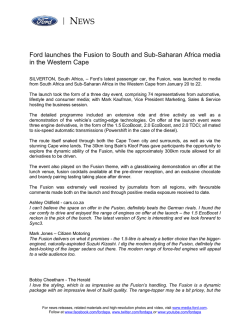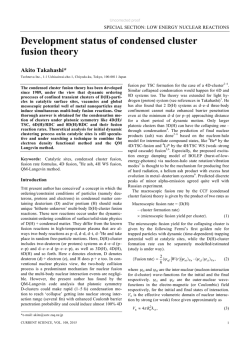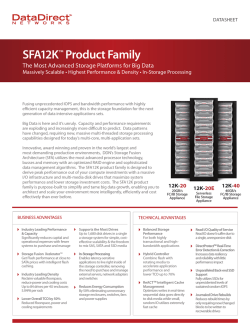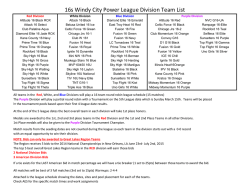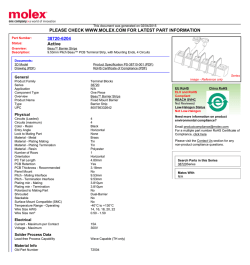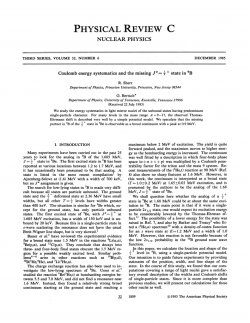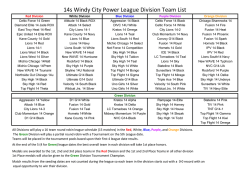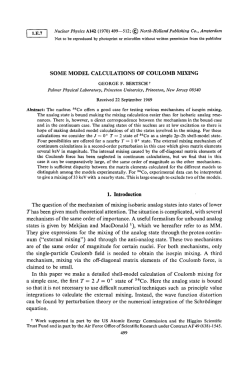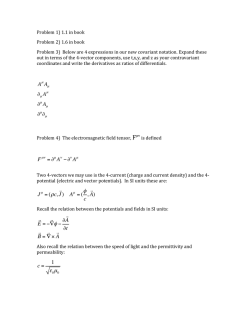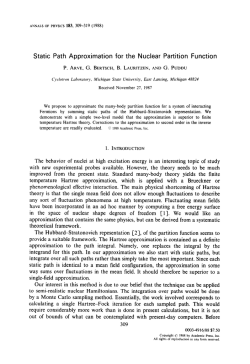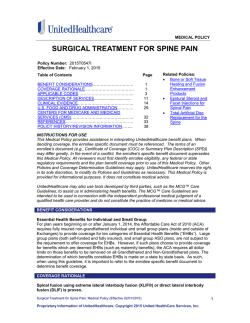
100. - Institute for Nuclear Theory
Nuclear Physics @ North-Holland A411 (1983) 275-288 Publishing SUBBARRIER Company FUSION H. ESBENSEN, AND DYNAMICAL JIAN-QUN DEFORMATIONS WU and G. F. BERTSCH Cyclotron Laboratory and Department of Physics and Astronomy, Michigan State University, East Lansing, MI 48824, USA Received (Revised 31 May 1983 25 July 1983) Abstract: The effect of dynamic deformation degrees of freedom in subbarrier fusion is calculated numerically in the coupled-channel representation. In the case we study, we find that the frozen approximation is quite accurate for low-lying collective vibrations. Perturbation theory based on the eikonal approximation is useful for excitation energies extending to the giant resonance frequencies, and it can be used to test the applicability of the frozen approximation. Giant resonances can give a significant contribution to the enhancement of subbarrier fusion. 1. Introduction Subbarrier fusion depends on energy and projectile target combination in a way that cannot be explained by standard one-dimensional barrier penetration models ’ -3). The internal degrees of freedom of the colliding system evidently play an important role at the large separations associated with subbarrier fusion. Internal degrees of freedom which have been considered include static deformations 4), zero-point motions of collective surface vibrations 5), and dynamical deformations at the classical turning point 6). Other processes such as transfer induced fusion, and neck formation 3’6, have been suggested, but no quantitative calculations have yet appeared. It is possible to lit the fusion data with phenomenological optical potentials ‘), but this does not further the understanding of the dynamics of subbarrier fusion. Other fusion reactions, with static deformed nuclei, seem to be well understood in terms of an orientation dependence of the fusion process [see e.g. refs. *, ‘)I. The model for the enhancement of subbarrier fusion cross sections due to zero-point motions of collective surface vibrations studied in ref. 5, is a natural extension of this treatment, averaging instead over all nuclear shapes compatible with the vibrational ground states of the interacting nuclei. However, this procedure is only justified for small one-phonon excitation energies ho. In the following we investigate the limitations of this model by considering the effect of nuclear excitations for finite excitation frequencies of surface modes. We 275 276 H. Esbensen et al. 1 Subbarrier fusion study a two-dimensional barrier penetration problem, one dimension being the radial separation of colliding nuclei and the other a surface degree of freedom. We solve the problem using a coupled-channel treatment and check the results in the limits ho = 0 and ho = co, where the exact results are known. Simple estimates of the effect of zero-point motions on fusion are discussed in the frozen approximation (i.e. for o + 0) in sect. 4. A perturbation expansion based on the eikonal approximation is presented in sect. 5. 2. Coupled-channel treatment The coupled-channel formalism for barrier penetration has been used in connection with fission lo ) to test various semiclassical methods. We shall adopt a similar treatment for fusion and study the dynamical effects associated with the excitation of collective surface vibrations in a two-dimensional model. The relative motion of two ions, with reduced mass M, is governed by the Coulomb and nuclear interaction. We consider only head-on collisions (1 = 0) and assume that the nuclear interaction UN depends on the surface-surface distance r-R, -R, -s between the ions, which leads to a coupling of the relative motion to a surface mode with amplitude s. The total hamiltonian is H = - & $ +V(r, s) + H,,,, (1) where the total interaction is Z,Z2e2 W, s) = ___ r + U,(r - s), (2) and the intrinsic hamiltonian for the surface vibration is H,,, = - ; $ ++Dti2s2. Here D is the mass parameter and o is the frequency of the surface mode. We have neglected Coulomb excitations for simplicity. The long-range Coulomb polarizations complicate the boundary conditions for the coupled-channel calculations. Their effect can be estimated as it was done in ref. 6), and they can be neglected in the case we study numerically. In the tunneling region we expect that excitations are mainly due to the nuclear field. The effect of the Coulomb field on the fusion process is discussed in the frozen approximation in sect. 4. The nuclear interaction is expressed in terms of the complementary error 271 H. Esbensen et al. 1 Subbarrier fusion function U,(r-s) = -$U,G erfc[(r-s-R, 1 -R,-AR&], (4) 2 where AR = 0.29 fm, Ri = 1.233Af-0.98A;+, u,, = 31.67 MeV.fm-‘, a = LO.63 A = 1.42 fm. The parameters are the same as those for the Wood-Saxon potential used in ref. “) except the diffuseness a, which has been adjusted so that the maximum nuclear attraction for these two interactions are identical (cf. the factor 4/A). The two interactions will therefore essentially lead to the same fusion cross section. We have chosen this parameterization because the matrix elements with the harmonic oscillator wave functions (eigenfunctions to eq. (3)) can be determined analytically through recursion relations. To solve the two-dimensional Schrijdinger equation fW(r, s) = (E +Po)$(r, s), (5) where E is the c.m. energy in the relative motion, we expand the wave function on a finite set of oscillator eigenfunctions 4,(s), (6) and obtain the coupled equations -- h2 a2 2Mar2+ (nlVln)-E+nho 1 tin(r) = - mIn<nlVm)lClm(r). (7) The matrix elements are <4W> = s WG)W, sM&). (8) The boundary conditions are ingoing waves at a certain c.m. distance r,in near the minimum of the total interaction - or decaying states, when E- nho is less than the total interaction at rmin, and Coulomb wave functions at r = rmax 278 H. Esbensen et al. / Subbarrier fusion somewhat outside the barrier, where the nuclear field vanishes, i.e. *,(r) + I T, exp( - ik,(min)r), for r 5 rmin bKA(r) for r 2 r,,,. + WCA(r), (9) Here hk,(min) is the radial momentum at rmin in the nth channel and t+!@!(r) are the outgoing and ingoing Coulomb wave functions in the different channels with an energy of E -niio in the relative motion. There is only an ingoing Coulomb wave function in the elastic channel. The fusion probability Pfus is the sum over all channels of the relative flux at rmin in each channel: (10) PFUS= 1 I7J%k,(min)/~. n To achieve a solution with these boundary conditions we use the method described in ref. lo ), which involves the inversion of a matrix. We also tried a perturbation expansion in the off-diagonal matrix elements, using the Green functions method, but for realistic cases this procedure failed due to the rather strong coupling between different channels. 3. Exact solvable limits It is convenient to characterize the surface vibration in terms of the frequency o and the standard deviation of the zero-point motion amplitude u = (h/2&0)*. We can check the numerical results of the coupled-channel calculations in two cases. In the sudden limit, i.e. for w = 0 and a finite (T, one can neglect the intrinsic oscillator hamiltonian in the total hamiltonian (1) and thus solve eq. (5) for frozen values of s. This leads to a solution of the form (11) N-, s) = h(r, sMo(s), where +&,s) is the solution to the equation (12) which satisfies the boundary conditions J/&, s) + IT(s)ev( - W)r), r 5 rmin r h tC:b(r)+Ws)h+:+b(r) ’ 3 rmax. (13) 279 H. Esbensen et al. / Subbarrier fusion Here M(s) is the momentum in the relative motion at rmin, and it depends on s. The total fusion probability is therefore Pfus= s ds(~o(s))‘lT(s)12hk(s)lJ2ME. (14) This is essentially the procedure used in ref. 5), except that the transmission coefficients used there were obtained from the generalized WKB method Ii). The usual adiabatic limit, where the oscillator is assumed to be in the local ground state during the fusion process, is not useful in the domain of realistic ovalues, because the adiabatic trajectory has a discontinuity in the (r, s) plane with the average s-coordinate of the local ground state jumping from one minimum in the potential to another. We shall make use of the extreme adiabatic limit (w being very large) in which case the trajectory goes through the barrier in the elastic channel. Then the wave function satisfies Il/(r, s) = t,b,,,(r)~&), where $Jr) is a solution to the equation (15) 4. Simple formulas for 0 = 0 In this section we give some simple formulas that can be used to estimate the effect of zero-point motions on subbarrier fusion cross sections in the limit o = 0. Including a centrifugal potential in the total interaction we can determine barrier penetration factors from the Hill-Wheeler formula 12) P,(s) = 2x 1 +exp [ ( 1/,(1,s)--E h%(& s) )I . -l (16) These penetration factors depend on the angular momentum 1 and the amplitude s of a surface mode through the height of the barrier V’,‘,(I,s),and through the quantity o,(l, s), which is obtained from a parabolic approximatiofi to the shape of the barrier and is given by (17) The main dependence on s occurs through the height of the barrier. Following the derivation in ref. ‘) one finds (with certain approximations valid for energies near and below the Coulomb barrier) that the s-dependent fusion cross section is given 280 H. Esbensen et al. / Subbarrier fusion CJ~~~(S) = zRf, ” zlog(l+exp(-~~~))), (18) where R,, is the c.m. distance at the Coulomb barrier for I = 0 and s = 0, and &g= ho,(l = 0, s = 0)/2X (19) The enhancement of subbarrier fusion cross sections due to zero-point motions of surface modes is therefore essentially due to fluctuations in the height V,,(s) of the Coulomb barrier. Similar to eq. (14) we can determine the average fusion cross section from the equation (20) where oA is the standard deviation of surface fluctuations due to a collective vibration of multipolarity A. We can simplify these expressions further by expanding V,,(s) to first order in s. For the interaction used in eq. (2) one finds that av,, as au, c--c as s=o --=-- au, ar Z,Z,e' (21) GB at the Coulomb barrier. In general the nuclear force on a deformation degree of freedom may differ from the force on the relative motion, as e.g. in the proximity description 13). Moreover, there will also be a contribution from the Coulomb monopole-multipole interaction, which for head-on collisions depends on the multipolarity A and the amplitude si, 1 of the surface mode as follows si, I. (22) Instead of eq. (21) one should therefore use the expression av,, -= asi, 1 (23) where au, L=-asi,, au, 3 ~~ 1-1 7-p- 21+1 R,, (> i is evaluated at the Coulomb barrier. (230 H. Esbensen et al. / Subbarrier fusion 281 Far below the Coulomb barrier the fusion cross section is seen to have an exponential dependence on the c.m. energy. In this limit one finds that (24) The enhancement factor can be quite large. It is more convenient effect in terms of a modified effective Coulomb barrier, viz. to express the When several surface modes are important, their contributions to the reduction of the effective Coulomb barrier should be added. From these estimates one can see under what circumstances one would expect a large effect of zero-point motions on subbarrier fusion. The quantity so, defined in eqs. (19) and (17), is rather insensitive to the projectile/target combination. The dominant factor on the relative change of the effective Coulomb barrier is the Coulomb force at the Coulomb barrier. The factor L, 1 defined in eq. (23) can be estimated, for example, from the proximity description i3). Some examples of typical values are given in table 1. They were obtained by integrating the proximity TABLE 1 Values of A, ir defined Reaction O+Sm O+Sm Ar+Sm ArfSm Ni+Ni The collective in eq. (23) and calculated from the proximity description, multipolarities I, I = 2 to 5, and for various reactions (i) Sm 0 Sm Ar Ni mode is in the nucleus 1=2 0.60 0.43 0.59 0.51 0.57 (i) shown are given for different 3 4 5 0.73 0.21 0.66 0.37 0.52 0.72 0.06 0.59 0.17 0.36 0.65 7 x 1o-4 0.46 0.04 0.20 in the second column. force and the forces on shape degrees of freedom over the area of the crevice between spherical nuclei. The factor fi, A is generally largest for a light ion on a heavy target, the heavy ion containing the surface mode. In the example studied in ref. ‘j), and for the interaction used there, the value of A, 1 was about 0.46. The effect of zero-point motions was therefore found to be small, and it was almost canceled by the Coulomb polarization of the quadrupole state that was studied. For more asymmetric collisions, such as the I60 + Sm reactions studied in refs. is ‘), the Coulomb polarization has a small effect on the subbarrier enhancement. 282 H. Esbensen et al. / Subbarrier fusion 5. Finite w We have simple and exact results for o = 0 and o = co, and it would be nice to understand how the penetrability at finite o interpolates between these two limits. For small values of w we can treat the intrinsic hamiltonian of the oscillator as a perturbation that acts on the solution in the sudden limit (o = 0). To pursue this idea it is convenient first to separate the total wave function I&, s) = Il/&, s)&(s) as in eq. (1 l), and to rewrite the Schrijdinger equation in terms of rC/&,s) as follows : (26) (27) The oscillator mass has here been expressed by o and the quantity CJdefined in sect. 3. We will estimate the effect of the operator Y by evaluating it on the eikonal approximation to es. We shall only consider the case of subbarrier fusion and neglect the effect of excitations outside the barrier. In the classically forbidden region the wave function is N Jleilc ev( - @(r,S)), (28) where s WI @(r, s) = drJ2M( V(r, s) - Q/h, I (29) r0 being the outer turning point. We may then evaluate the derivatives in eq. (27). In the spirit of the eikonal approximation, we shall drop the second derivative term a2@/las2.This term produces a divergence at the classical turning points, just as in the ordinary WKB approximation consideration of a2@/ar2 leads to a prefactor on the eikonal which diverges at turning points. We then find that the operator Y is equivalent to the function Veik = -ima aa 2 ( >-hws~ as as’ (30) which we can include in the definition of an effective action integral s 10 @e,,(s) = ri dr,/2M(V(r, S) + YeiL - E)/h. (31) H. Esbensen et al. / Subbarrier fusion 283 The limits of integration are the turning points. As in the generalized WKB approximation il) we can now construct a penetrability; weighting it with the ground-state distribution of s we obtain the average fusion probability Pfus= s W40(s))2(1 +expW,&)))-‘. (32) The derivation of eqs. (3Ok(32), being based on the eikonal approximation, holds only far below the barrier. A more detailed derivation, with a proper treatment of the regions near classical turning points, would be desirable. The success of the generalized WKB approximation, however, gives some confidence in the use of these equations even near the barrier. It is instructive to evaluate this expression with more simplifying assumptions. Let us assume that the barrier is rectangular, that the force F = -i3V/& in the sdirection is constant, and that the amplitude of zero-point motion is small. For energies far below the barrier the integrals can then be evaluated to obtain the result Pfus = Piti exp(2(For/h)2(1 -+r)). (33) Here r is the “time” that the particle spends under the barrier, defined as r = ML/,/m, where L is the length of the barrier. We see that the correction due to a finite w depends exponentially on the frequency, with a coefficient that depends quadratically on the force F, and cubically on the “time” Z. Eq. (33) has the correct functional dependence on the parameters of the system, but unfortunately is not quantitatively accurate for our purpose. This is due to the fact that the momentum transfer to the oscillator, represented by a@/&, is essentially accumulated in a region near the inner turning point, where av/as is largest. Thus the effect of Y is poorly represented by its value in the middle of the barrier. We shall therefore use the expressions in eqs. (29r(32) when comparing with the coupled-channel results discussed in the next section. In the limit of high frequencies, the adiabatic approximation becomes applicable. This yields a penetrability whose o-dependence arises from the dependence of the adiabatic path on w. We find that the deviation from the adiabatic limit behaves as l/o’. From the numerical calculations, discussed in the next section, this behaviour applies to ho > 10 MeV. 6. Coupled-channel results We study the reaction ’ 6O + i4’Sm for head-on collisions (I = 0), in order to see how much the results obtained in ref. 5, are affected by excitations during the fusion process due to a finite value of the one-phonon excitation energy ho. 284 H. Esbensen et al. / Subbarrier fusion IO 3 a- IO- IO- Fig. 1. Fusion probabilities for the reaction 160+ 14*Sm are shown as function of the cm. energy. The results are obtained from coupled-channel calculations, for various values of the one-phonon excitation energy hw. The standard deviation of the zero-point motion amplitude is (I = 0.27 fm. The fusion probability is shown in fig. 1 as function of the c.m. energy. Both the extreme adiabatic and the sudden limit are shown together with the results for Ao = 1 MeV and 10 MeV. The value of 0 was 0.27 fm, which is close to the value obtained both for the low-lying quadrupole and octupole states in i4’Sm. Since the excitation energy ho for these states are 0.55 MeV and 1.16 MeV, respectively, we can conclude that the dynamical effect due to the kite value of ho will not lead to a major reduction of the subbarrier fusion cross sections obtained in ref. ‘). In fig. 2A we show in more detail the dependence on the values of 0 and hw, at a c.m. energy of 57 MeV. The results are seen to decrease smoothly with increasing values of ho from the sudden limit towards the adiabatic limit, where the effect of zero-point fluctuations only enters through the average potential in the elastic channel. From this figure and the estimates in sect. 4 and table 1 of the factors f;:, 1 (due to curvature corrections and the Coulomb field) we can now decide which states are important for the enhancement of subbarrier fusion. For the octupole state in I60 (ho - 6 MeV and 0 - 0.6 fm) one would expect a large effect. From H. Esbensen et al. / S~bar~ier COUPLED fusion EIKONAL CHANNEL 285 APPROX. 9 n!! IO-3 0.05 0.1 0.05 0.1 Fig. 2. Fusion probabilities for the reaction ‘60+“4sSm at a cm. energy of 57 MeV are shown as a function of u*, for different values of ho. Coupled-channel results are displayed in (A), and the results from the eikonal approximation, eqs. (29b(32), are shown in (B). table 1, however, we obtain the effective value (fi, ncr) N 0.13 fm, and from fig. 2 one finds that the enhancement factor for fusion, compared to the adiabatic limit, is only of the order of 1.3. For the quadrupole state in I60 and the giant quadrupole and giant octupole states in Sm one finds results of the same order of magnitude. All together these states lead to a significant contribution (a factor of 2 to 3), but the dominant enhancement is still due to the low-lying states in Sm mentioned above. The coupled-channel calculations were checked against the exact results for ho = 0, eqs. (12)-(14). To achieve agreement we shouid include about 10-15 channels in the coupled-channel calculations. According to eq. (24) one would expect that the log(Pr,,) should be a straight line for 210 = 0. The deviations from this dependence in fig. 2 are mainly due to the fact that for large values of CTthere are cont~butions to the fusion probability from large values of s for which the exponential approximation to the Hill-Wheeler formula is not very good. For comparison we show in fig. 2B the results obtained from the eikonal approximation, eqs. (29)-(32). The agreement is remarkably good for small values of ho. Some deviations from the coupled-channel results are seen for hw = 10 MeV and large values of 6. For even larger values of hw the eikonal approximation fails more dramatically. For realistic values of the parameters the numerical coupled-channel calculations can be quite difficult. The reason for this is seen in a comparison with the exact results for ho = 0. The location of the maximum of the density I$(r,s)lz in the sdirection is shifted inside the barrier due to the strong s-dependence of the 286 H. Esbensen et al. 1 Subbarrier fusion 12 14 16 r(fm) Fig. 3. Contours of equal density jJl(r, s)12 are shown in the (r, s) plane. The wave function is a solution to eqs. (11~(13), the sudden limit, for the reaction 160+14sSm at a c.m. energy of 57 MeV, with o = 0.27 fm. The shaded area inside the dashed curve is the classically forbidden region. The wave function is essentially a standing wave outside the barrier. Note that s shifts from zero to about 0.5 fm in the penetrating wave. penetration factor. The shift s,, can be estimated from the Hill-Wheeler approximation used in sect. 4, and for energies far below the barrier one finds that so zlzzeZOz. EoR;, 2i (34) This is illustrated in fig. 3, where some contours of equal density are shown. They were obtained from the exact treatment for ho = 0, i.e. from eqs. (1 l)-(13). The shaded area inside the dashed curve is the classically forbidden region. In order to reproduce this figure in detail from a coupled channel calculation one would have to include many more channels than mentioned above. For heavy systems, where the shift given in eq. (34) and thus the enhancement factor in eq. (24) can be much larger than in the present example, more serious numerical diffkulties can arise, in particular when many decaying states become important [cf. ref. ‘“)I. The numerical treatment of these states requires a high precision since the wave functions of decaying states varies over many orders of magnitude inside the barrier. Such problems already occur in the reaction H. Esbensen et al. / Subbarrier fusion 287 160+148 Sm for hw 2: 4-8 MeV. Thus the results in fig. 2A are somewhat uncertain for rio = 3 MeV and large values of U. An interesting aspect of these findings is that the enhancement of subbarrier fusion originates from the tail of the ground-state density of the collective mode (cf. eq. (34) and fig. 3). In particular for heavy systems, where the far tail is probed, one should expect to see some effect of anharmonicities in the collective hamiltonian. 7. Conclusion We have studied subbarrier fusion and the dynamical effect associated with the nuclear excitation of collective surface vibrations during the fusion process. Previous calculations that neglect these excitations but include the effect of groundstate fluctuations of collective vibrations, showed a large enhancement of subbarrier fusion cross sections compared to standard one-dimensional barrier penetration models. Our present results show that nuclear excitations during the barrier penetration only lead to a minor modification of these results, when the collective state is low-lying (say ho 5 1 MeV). From estimates of the proximity forces acting on surface modes we conclude that the most significant effect of zero-point motions on subbarrier fusion should be seen in asymmetric collisions, where the heavy reaction partner contains very collective low-lying surface modes. In this case the effect of long-range Coulomb polarizations will be relatively unimportant. In the reaction we studied (O+Sm) we thus found that the effect of collective states in the lighter ion was strongly suppressed by proximity-type curvature corrections to the nuclear field, whereas the effect of giant resonances in the heavy ion was reduced by adiabaticity. All these states gave a significant contribution to the enhancement of subbarrier fusion, but the dominant effect came from the low-lying collective states in the heavy ion. We used both a coupled-channel treatment and a perturbation expansion based on the eikonal approximation. A key parameter is the product of the zero-point fluctuation of the nuclear potential, Fa in our notation, and the barrier tunnelling time T, which in turn relates directly to the steepness of the penetrability as function of energy. When this parameter is large, as is the case in realistic situations of interest, the enhancement is large but also the coupled channel calculations become difficult. Also, the perturbation expansion for the odependence is proportional to this parameter. However, the eikonal approximation gives remarkably accurate results for low-lying collective states. Our present study does not provide an explanation of the detailed features of the subbarrier fusion observed in ref. 3). Particle-transfer processes are probably important 14). However, presently there is no alternative to the coupled-channel technique for calculating their influence on subbarrier fusion. After completing this manuscript, we became aware of related works on barrier 288 H. Esbensen et al. / Subbarrier fusion penetration 15-17), in which the relative motion is coupled to an internal harmonic degree of freedom by a linear coupling. Brink et al. 15), consider a model of fission, concentrating on the adiabatic regime, i.e. w large in our notation. They also discuss the small w-regime, obtaining an expression similar to our eq. (33). Krappe et al. 16), calculate fusion in the framework of the model with a phenomenological internal oscillator degree of freedom, and show that it is possible to get excellent fits with this type of parametrization. We acknowledge PHY-80-17605. support by the National Science Foundation under grant References 1) R. G. Stokstad et al., Phys. Rev. Lett. 41 (1978) 465; Phys. Rev. C21 (1980) 2427; Z. Phys. A295 (1980) 269 2) W. Reisdorf et al., Phys. Rev. Lett. 49 (1982) 1811 3) M. Beckerman ef al., Phys. Rev. C23 (1981) 1581; C25 (1982) 837; Phys. Rev. Lett. 45 (1980) 1472; 50 (1983) 471 4) R. G. Stockstad and E. E. Gross, Phys. Rev. C23 (1981) 281 5) H. Esbensen, Nucl. Phys. A352 (1981) 147; and in Nuclear physics, ed. C. H. Dasso (NorthHolland, Amsterdam, 1982) p. 645 6) S. Landowne and J. R. Nix, Nucl. Phys. A368 (1981) 352 7) R. Lipperheide, H. Rossner and H. Massmann, Nucl. Phys. A394 (1983) 312 8) C. Y. Wong, Phys. Rev. Lett. 31 (1973) 766 9) W. Scobel ef al., Phys. Rev. Cl1 (1975) 1701 10) P. Ring, H. Massmann and J. 0. Rasmussen, Nucl. Phys. A296 (1978) 50 11) N. Frijman and P. 0. Friiman, JWKB approximation (North-Holland, Amsterdam, 1965) 12) D. L. Hill and J. A. Wheeler, Phys. Rev. 89 (1953) 1102 13) R. Blocki, J. Randrup, W. H. Swiatecki and C. F. Tsang, Ann. of Phys. 105 (1977) 427 14) R. A. Broglia, C. H. Dasso, S. Landowne and A. Winther, Phys. Rev. C27 (1983) 2433 15) D. M. Brink, M. C. Nemes and D. Vautherin, Ann. of Phys. 147 (1983) 171 16) H. J. Krappe, K. MBhring, M. C.Nemesand H. Rossner, preprint, Hahn-Meitner Institute (Berlin, 1983) 17) S. Y. Lee and N. Takigawa, preprint, Tohoku University (Japan, 1983)
© Copyright 2025
